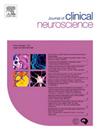Differences in neuroradiological impacts of hematoma volume and midline shift on clinical symptoms and recurrence rate in patients with unilateral chronic subdural hematoma
IF 1.9
4区 医学
Q3 CLINICAL NEUROLOGY
引用次数: 0
Abstract
Objective
Chronic subdural hematoma (CSDH) is a prevalent neurosurgical condition, particularly among the elderly. Hematoma volume (HV) and midline shift (MLS) on CT imaging are critical for assessing CSDH severity and recurrence risk. Brain atrophy has also been linked to recurrence. This study investigates the impact of HV and MLS on clinical symptoms and recurrence, considering brain atrophy.
Methods
A retrospective analysis was conducted on patients with unilateral CSDH who underwent burr hole surgery for symptoms such as headache, disturbances of consciousness, hemiparesis, and gait disturbance. HV, MLS, and relative cortical atrophy index (RCAI) were measured using preoperative (pre-) and postoperative (post-) CT images. The rate of change in RCAI (RCAI-CR) between pre- and post-CT images was calculated to assess contralateral brain compression. Associations between HV, MLS, RCAI, RCAI-CR, symptoms, and recurrence were analyzed.
Results
The study included 293 patients (mean age 79.4 ± 12.1 years), with a recurrence rate of 15.0 % (44/293). Pre-HV (per 10 mL) was significantly associated with hemiparesis and gait disturbance (odds ratio [OR] 1.12, 95 % confidence interval [CI] 1.03–1.21, p = 0.011; OR 1.14, 95 % CI 1.05–1.24, p = 0.003). Pre-MLS was significantly correlated with disturbances of consciousness (OR 1.26, 95 % CI 1.14–1.39, p < 0.001) and was elevated in patients with high RCAI-CR. Significant predictors of recurrence included Pre-HV (per 10 mL) (OR 1.16, 95 % CI 1.03–1.31, p = 0.014), postoperative subdural cavity volume (per 10 mL) (OR 1.18, 95 % CI 1.02–1.36, p = 0.026), antiplatelet drug use (OR 0.23, 95 % CI 0.06–0.89, p = 0.032), and CT classification (OR 2.35, 95 % CI 1.15–4.82, p = 0.020).
Conclusions
HV and MLS have distinct clinical implications in CSDH. Pre-HV is linked to motor disturbances, while Pre-MLS correlates with disturbances of consciousness, with high RCAI-CR indicating significant brain compression. HV is a key predictor of recurrence, while MLS and RCAI are not. These findings may improve outcome prediction and management strategies.
求助全文
约1分钟内获得全文
求助全文
来源期刊

Journal of Clinical Neuroscience
医学-临床神经学
CiteScore
4.50
自引率
0.00%
发文量
402
审稿时长
40 days
期刊介绍:
This International journal, Journal of Clinical Neuroscience, publishes articles on clinical neurosurgery and neurology and the related neurosciences such as neuro-pathology, neuro-radiology, neuro-ophthalmology and neuro-physiology.
The journal has a broad International perspective, and emphasises the advances occurring in Asia, the Pacific Rim region, Europe and North America. The Journal acts as a focus for publication of major clinical and laboratory research, as well as publishing solicited manuscripts on specific subjects from experts, case reports and other information of interest to clinicians working in the clinical neurosciences.
 求助内容:
求助内容: 应助结果提醒方式:
应助结果提醒方式:


